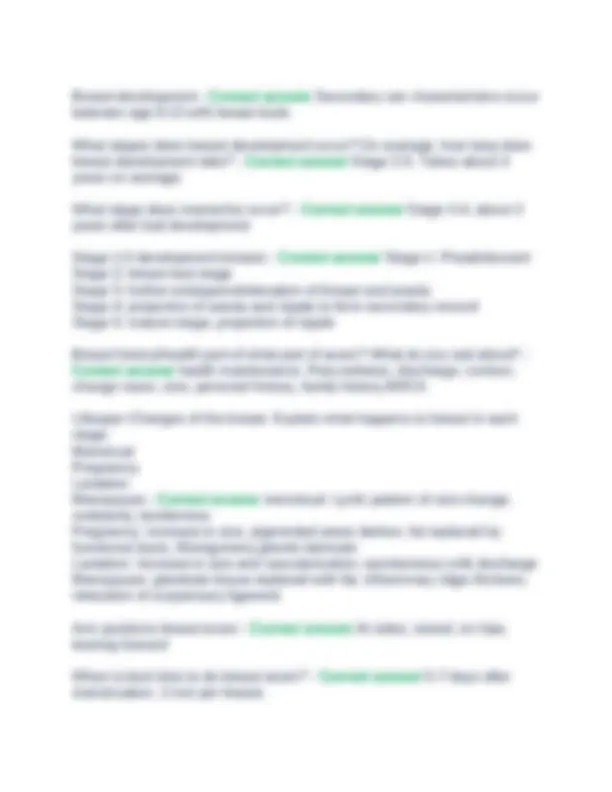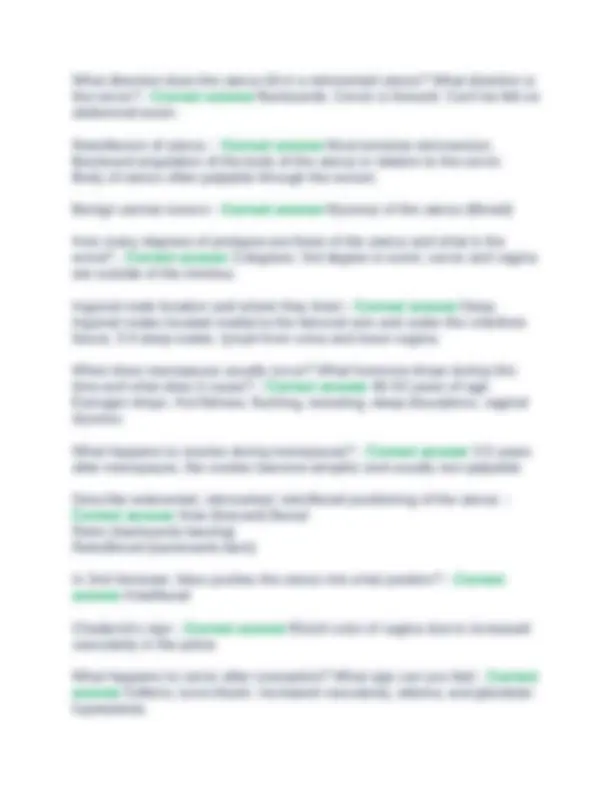











Study with the several resources on Docsity

Earn points by helping other students or get them with a premium plan


Prepare for your exams
Study with the several resources on Docsity

Earn points to download
Earn points by helping other students or get them with a premium plan
Community
Ask the community for help and clear up your study doubts
Discover the best universities in your country according to Docsity users
Free resources
Download our free guides on studying techniques, anxiety management strategies, and thesis advice from Docsity tutors
This detailed exam study guide includes 198 essential questions and answers tailored for Advanced Health Assessment midterms. Covering a wide array of cardiovascular and peripheral vascular topics, this guide is an invaluable resource for healthcare students and professionals preparing for exams. Key highlights: Cardiovascular System: Risk factors, fundoscopic findings, JVP measurements, PMI locations, murmurs, extra heart sounds (S3, S4), and auscultation techniques. Heart Murmurs: Grading, characteristics, diagnosis-related murmurs, and associated pathologies (e.g., aortic stenosis, mitral regurgitation, MVP). Peripheral Vascular Disease: Arterial anatomy, ischemic symptoms, and specific arteries feeding various regions. Assessment Techniques: Differentiation between carotid vs. jugular pulse findings and accentuated sounds in different positions. This guide provides clear explanations to master diagnostic techniques and apply knowledge in clinical settings.
Typology: Quizzes
1 / 17

This page cannot be seen from the preview
Don't miss anything!










Risk factors cardiovascular disease (5) - Correct answer HTN, hyperlipidemia, smoking, obesity, family history What conditions would you see an abnormal fundoscopic exam? Name 4 - Correct answer HTN, diabetes, increased ICP Describe carotid pulse/auscultation findings - Correct answer Vigorous upstroke, level of pulsations not changed by position or respiration Describe internal jugular pulse/auscultation findings - Correct answer Rarely palpable, soft, 2 elevations per heart beat, level of pulsations change with position and drops with inspriration Normal JVP - Correct answer 6-8cmH Where do you feel for PMI? - Correct answer 5th ICS slightly medial to MCV (if deviated to L or >2cm, abnormal) What are forceful cardiac contractions referred to as? - Correct answer Lifts, heaves What are vibrations of loud cardiac murmurs referred to as? - Correct answer Thrills What are yellowish plaques/skin lesions caused by the accumulation of fat macrophage immune cells? - Correct answer Xanthomas (increased risk coronary artery disease) Poor oxygen perfusion to distal tissues of hands and feet results in? - Correct answer Clubbing
Poor oxygen delivery to peripheral tissues hands and feet? - Correct answer Cyanosis What does LLD position accentuate for heart sounds? - Correct answer Left-sided S3, S4, mitral murmurs (stenosis) What does leaning forward, exhaling completely and holding breath accentuate for heart sounds? - Correct answer Aortic murmurs (regurgitation) What does squatting/handgrip accentuate for heart sounds? - Correct answer Mitral valve prolapse (increased afterload and increased ventricular volume) What heart sound: closure of mitral and tricuspid valves, heard best at apex with the bell, immediately precedes carotid upstroke - Correct answer S What heart sound: closure of aortic and pulmonic valves, best heard at base (R and L 2nd ICS) with diaphragm, louder than S1 - Correct answer S Where and when (insp/exp) do you hear splitting of S2? - Correct answer Pulmonic area during peak inspiration What causes splitting of S2? - Correct answer Delayed closure of pulmonic valve; increased blood flow What causes S3 gallop? When does it occur? Where do you listen for it? - Correct answer Rapid ventricular filling. The third heart sound is caused by vibration of the ventricular walls, resulting from the first rapid filling so it is heard just after S2. The third heart sound is low in frequency and intensity. Sloshing sound. "Ken-tuck-ee". Occurs in early diastole. Associated dilated cardiomyopathy. Apex with bell in LLD. What extra heart sound may be physiologic in children and in pregnancy? When is it considered pathologic? - Correct answer S3; >40 pathologic What causes S4? When does it occur? Where do you listen for it? - Correct answer Atrial contraction. Atrial sound related to vibrations caused by atrial systole (caused by increased resistance to LV filling by atrial
Physiologic murmurs are caused by? - Correct answer Increased blood flow. Fever, anemia, pregnancy, hyperthyroidism Name the systolic murmurs: 7 - Correct answer aortic/pulmonic stenosis, mitral/tricuspid regurgitation, MVP , ASD, VSD What murmur radiates to the carotids? - Correct answer Aortic stenosis What murmur is holosystolic and worse with hand grip/squat? Where do you listen for it? - Correct answer Mitral regurgitation; 5th ICS MCL What murmur has a mid-systolic click? - Correct answer MVP Name the diastolic murmurs: 4 - Correct answer aortic/pulmonic regurg, mitral/tricuspid stenosis What type of murmurs are ASD, VSD, pericardial friction (scratchy) rub? - Correct answer Continuous "harsh machinery" murmurs Aortic aneurysm from syphilis or Marfan's, pericarditis, prostehtic valves and subacute bacterial endocarditis can cause what sounds? - Correct answer Murmurs When you hear a systolic ejection murmur, what could the possible diagnosis be? - Correct answer Normal, aortic stenosis, pulmonic stenosis, hypertrophic obstructive cardiomyopathy, ASD, TEF When you hear a early diastolic murmur, what could the possible diagnosis be? - Correct answer Aortic or pulmonic regurgitation When you hear an ejection sound, what could the diagnosis be? - Correct answer Aortic valve disease When you hear a holosystolic murmur, would could the diagnosis be? - Correct answer Mitral or tricuspid regurgitation When you hear a late diastolic murmur, would could the diagnosis be? - Correct answer Mitral or tricuspid stenosis
You hear a systolic click with a late systolic murmur. What is your diagnosis? - Correct answer MVP You hear an opening snap with a diastolic rumble. What is it? - Correct answer Mitral stenosis What heart sound is normal in children and occurs in heart failure? - Correct answer S What heart sounds is physiological and is in various diseases? - Correct answer S History for peripheral vascular disease - Correct answer site, quality, exacerbating factors, relieving factors, timing, progression Name the artery that feeds the buttock and hip - Correct answer Aortoiliac Name the artery that can cause erectile dysfunction - Correct answer Iliac- pudendal Name the artery that feeds the thigh - Correct answer Common femoral or aortoiliac Name the artery that feeds the upper calf - Correct answer Superficial femoral Name the artery that feeds the lower calf - Correct answer Popliteal Name the artery that feeds the foot - Correct answer Tibial or peroneal The following are symptoms of what? Persistent swelling of lower legs, edema improves with raising legs (worsens later in day), leg pain is dull, aching. Heaviness or cramping noted. Bluish discoloration of skin at the ankles. - Correct answer Chronic venous insufficiency (CVI) How do we grade edema? On a scale of _ to _ - Correct answer 1-4. Innocent venous hum in very small children normal CV finding? - Correct answer Yes
What area does neck level 6 drain? - Correct answer Paratracheal nodes: thyroid, larynx What area does neck level 4 drain? - Correct answer Supraclavicular nodes: larynx, hypopharynx, thyroid, non-neck sides (lung, breast, GI, GU) What area does neck level 3 drain? - Correct answer Mid-jugular nodes: hypopharynx, thyroid What scale do you use to evaluate CN VII function? What scale is it? - Correct answer House-Brackmann scale; 1-6. 4 = cannot close eye. 6 = complete paralysis. Opening snap is characteristic of what heart murmur? - Correct answer Mitral stenosis Where is JVP located? - Correct answer Assessed from pulsation in R internal jugular vein, which is directly in line with the superior vena cava and right atrium. Pregnancy may shift the apical impulse upwards and to the - Correct answer Expiratory splitting (rather than inspiratory) is indicative of what type of abnormality? - Correct answer Valvular S3 (ventricular gallop) pathologic in what population? - Correct answer Adults >40 (caused by high L ventricular filling pressures and abrupt deceleration of inflow) S4 (atrial gallup) pathologic in what population? - Correct answer L sided S4: HTN, aortic stenosis, ischemic and hypertrophic cardiomyopathy Types of tinnitus? - Correct answer Tonal and pulsatile External auditory canal: what is behind the anterior wall, posterior wall, and superior wall? - Correct answer Anterior: TMJ, Posterior: mastoid, Superior: Temporal lobe
5 branches of CN VII - Correct answer temporal, zygomatic, buccal, mandibular, cervical (platysmal) What is CN VII and what is it responsible for? - Correct answer Facial nerve, facial movement (5 branches) What cranial nerve runs through the inner ear? What is it responsible for? - Correct answer CN VIII (vestibulocochlear); balance/sensation Range of Hz inner ear? - Correct answer 200-20, Where is the base and apex of inner ear? What Hz can be heard at each? - Correct answer Base: 20,000 (high freq) Apex: 200 (low freq) Sound lateralizes to affected ear in what type of hearing loss? - Correct answer Conductive Sound lateralizes to unaffected ear in what type of hearing loss? - Correct answer Sensory AC>BC - Correct answer Normal or sensory hearing loss BC>AC - Correct answer Conductive hearing loss Name 3 parts of vestibular exam - Correct answer Oculomotor testing, cerebellar testing, basic balance function 3 parts oculomotor exam - Correct answer Unidirectinoal nystagmus, head thrust, dix-hallpike Balance function tests (3) - Correct answer Gait, Romberg, Fakuda step test Important rhinnorhea history? - Correct answer History skull base fracture Important smell loss history? - Correct answer Nutritional deficiency: zinc What is CN1? - Correct answer Olfactory nerve What drains into middle meatus? - Correct answer Maxillary sinuses
Breast development - Correct answer Secondary sex characteristics occur between age 8-13 with breast buds What stages does breast development occur? On average, how long does breast development take? - Correct answer Stage 2-5. Takes about 4 years on average. What stage does menarche occur? - Correct answer Stage 3-4, about 2 years after bud development Stage 1-5 development breasts - Correct answer Stage 1: Preadolescent Stage 2: breast bud stage Stage 3: further enlargemnt/elevation of breast and areola Stage 4: projection of areola and nipple to form secondary mound Stage 5: mature stage, projection of nipple Breast history/health part of what part of exam? What do you ask about? - Correct answer health maintenance. Pain,redness, discharge, contour, change mass, size, personal history, family history BRCA Lifespan Changes of the breast. Explain what happens to breast in each stage: Menstrual Pregnancy Lactation Menopause - Correct answer menstrual: cyclic pattern of size change, nodularity, tenderness Pregnancy: increase in size, pigmented areas darken, fat replaced by functional ducts, Montgomery glands lubricate Lactation: increase in size and vascularization, spontaneous milk discharge Menopause: glandular tissue replaced with fat, inframmary ridge thickens, relaxation of suspensary ligament Arm positions breast exam - Correct answer At sides, raised, on hips, leaning forward When is best time to do breast exam? - Correct answer 5-7 days after menstruation. 2 min per breast.
What do these findings describe? Location, size, deliniation of borders, consistency, mass, shape, mobility, tenderness, skin changes - Correct answer Mass findings for breast What are supernumerary breasts? - Correct answer Non-functional embryonic milk line from groin to axilla. Glandular tissue or pigmented lesion. Axillary adenopathy is due to what? - Correct answer Arm or breast infection. Small lump under armpit. What causes gynecomastia? - Correct answer Common in adolescents due to decreased ratio of androgens to estrogens. Name the condition: Peak incidence 35-50 years of age, commonly UOQ, tenderness with menses, rapid development, firm or fluctuant. - Correct answer Cyst Name the condition: common benign solid tumor, <25 years old, common UOQ, non-tender, mobile, smooth rubbery firm. Most common finding. - Correct answer Fibroadenoma. Cyclic or non-cyclic pain? No relationship to menses, post-menopausal, calcification and ductal dilation - Correct answer Non-cyclic pain Malignant neoplasm findings - Correct answer solitary, unilaterla, firm, fixed, non-tender, dimpling, edema, scaling, retraction ACOG recommendations for clinical breast exam: - Correct answer 1- years age 20-39, yearly >40. Mammography recommendations: ACS, ACOG, USPSTF - Correct answer ACS: 45-54 yearly, >55 q2 years ACOG: annually 40-74 years old USPSTF: Q2 years 50- What fissure divides each lung in half? - Correct answer Oblique fissure
put your hands to check for symmetry? - Correct answer Over large airways is greatest. will diminish as you move peripherally. 10th rib. Decreased/absent palpation is due to? - Correct answer trapped air, thick pleura, effusion, obstructive, massive pulmonary edema Increased palpation due to? - Correct answer lung consolidation/compression/mass; excess fluids or non-obstructive secretions Normal percussion sounds. - Correct answer Resonant (adult) Hyperresonant (child) If you hear hyperresonnance upon percussion for an adult, what do you think is going on? - Correct answer Increased air. Pneumothorax or emphysema. Is 5-6cm diaphramatic excursion findings normal? - Correct answer Yes What type of breath sound? Exp > Insp or about equal - Correct answer Bronchial/tracheal (tubular) What type of breath sound? Insp = Exp. Heard over bronchus and upper right posterior field, medium pitch. - Correct answer Bronchovesicular (not normal if heard peripherally) What type of breath sound? Insp > Exp. Soft and whispery quality, low pitched. - Correct answer Vesicular Represents opening of small airways or air bubbling through secretions. Early mid or late inspiration. Fine, medium or coarse. - Correct answer Crackles (rales) Represents secretions in large airways. "Snoring". Low pitched. During inspiration and expiration. May change with cough. - Correct answer Ronchi A continuous breath sound with a high-pitched musical quality during inspiration or expiration. Occurs due to obstruction of small airways. - Correct answer Wheezes
During inspiration and expiration, low-pitched grating sound. Indicates inflammation of pleural surfaces. - Correct answer Friction rub Voice transmission ______ (improved/worsened) if underlying lung field is consolidated (pneumonia) - Correct answer improved 3 terms that indicate abnormal voice transmission terminology: - Correct answer bronchophony, egophony, whispered pectorliloquy What type of percussion note would you hear in hyperinflated lungs of COPD or asthma? - Correct answer Hyperresonnance When fluid or solid tissue replaces air containing lung (pneumonia, pleural effusion, hemothorax) what percussion note do you hear? - Correct answer Dullness What lung sounds would you hear with abnormalities of the lung parenchyma (pneumonia, interstitial lung disease, pulmonary fibrosis, atelectasis, heart filaure) - Correct answer crackles What lung sounds would you hear with narrowed airways? (asthma, COPD, bronchitis) - Correct answer wheezes In pregnant women, for cervical exam, what do you use in place of a cervical brush? - Correct answer Cotton tipped applicator dipped in saline. What is the ectropion? - Correct answer Broad band of columnar epithelium encircling the os Transformation zone - Correct answer Squmocolumnar junction migrates towards the os What type of exam is this? helps palpate a retroverted uterus, the utersacral ligaments, cul-de-sac and adnexa. Screens for colorectal cancer in woen >50 years old. Assesses for pelvic pathology - Correct answer Recto-vaginal exam purposes
ACOG recommendations for first reproductive health visit - Correct answer 13-15 years old PAP smear guidelines - Correct answer 1st at age 21, then every 3 years til 29. Then Q 3 yeras age 30-65 and cotesting with HPV CDC recommendations screening STIs - Correct answer Qyear sexually active adolescents and women <25 years old Anterior compartment prolapse: AKA cystocele is prolapse of what organ? - Correct answer Bladder Posterior compartment prolapse: rectocele is prolapse of what organ? - Correct answer Rectum Hernia of intestines into vaginal wall? (seen posteriorly usually) - Correct answer Enterocele Apical compartment prolapse is also known as? - Correct answer Uterine prolapse. 1-3, 3 outside introitus. 2 at hymen. 1 into lower vagina. What are the common, 1 cm, smooth round yellow lesions that are found on the cervix? - Correct answer Nabothian cysts (transient) What are the findings that are usually friable and should be removed on the uterus? - Correct answer Polyps Where do a majority of cervical cancers appear? - Correct answer Squamocolumnar junction As we age, which direction does the squamocolumnar junction go? Inside or outside the canal. - Correct answer Inside Use what type of medium for bloody samples? - Correct answer liquid- based Anterior cervix means what direction uterus? - Correct answer Retroverted
Midline cervix means what direction uterus? - Correct answer mid position uterus Posterior cervix means what direction uterus? - Correct answer anteverted uterus Are fallopian tubes normally felt on exam? - Correct answer No What organs are in the adnexa? - Correct answer Ovaries, fallopian tbes, pelvic muslc eintegrity Rectovaginal exam performed in asymptomatic women? - Correct answer no Vulva is thin, atrophic, redder and more sensitive to touch. What type of patient? - Correct answer Prepubertal girl.